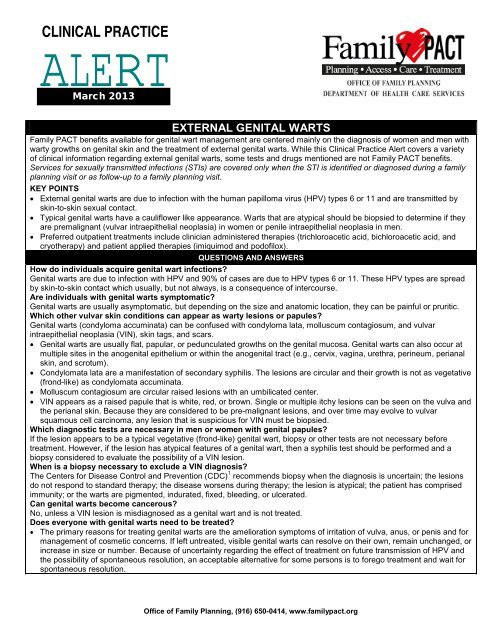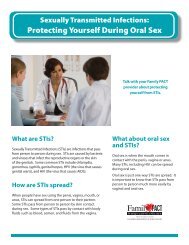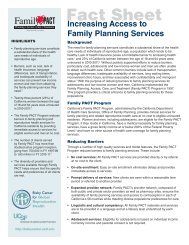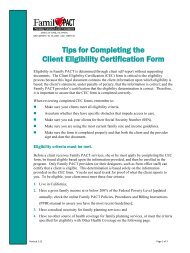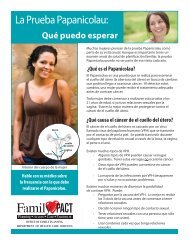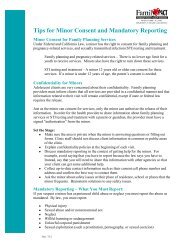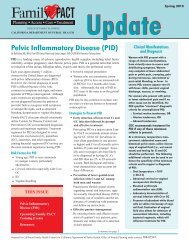External Genital Warts, Mar 2013 - Family PACT
External Genital Warts, Mar 2013 - Family PACT
External Genital Warts, Mar 2013 - Family PACT
Create successful ePaper yourself
Turn your PDF publications into a flip-book with our unique Google optimized e-Paper software.
CLINICAL PRACTICEALERT<strong>Mar</strong>ch <strong>2013</strong>EXTERNAL GENITAL WARTS<strong>Family</strong> <strong>PACT</strong> benefits available for genital wart management are centered mainly on the diagnosis of women and men withwarty growths on genital skin and the treatment of external genital warts. While this Clinical Practice Alert covers a varietyof clinical information regarding external genital warts, some tests and drugs mentioned are not <strong>Family</strong> <strong>PACT</strong> benefits.Services for sexually transmitted infections (STIs) are covered only when the STI is identified or diagnosed during a familyplanning visit or as follow-up to a family planning visit.KEY POINTS• <strong>External</strong> genital warts are due to infection with the human papilloma virus (HPV) types 6 or 11 and are transmitted byskin-to-skin sexual contact.• Typical genital warts have a cauliflower like appearance. <strong>Warts</strong> that are atypical should be biopsied to determine if theyare premalignant (vulvar intraepithelial neoplasia) in women or penile intraepithelial neoplasia in men.• Preferred outpatient treatments include clinician administered therapies (trichloroacetic acid, bichloroacetic acid, andcryotherapy) and patient applied therapies (imiquimod and podofilox).QUESTIONS AND ANSWERSHow do individuals acquire genital wart infections?<strong>Genital</strong> warts are due to infection with HPV and 90% of cases are due to HPV types 6 or 11. These HPV types are spreadby skin-to-skin contact which usually, but not always, is a consequence of intercourse.Are individuals with genital warts symptomatic?<strong>Genital</strong> warts are usually asymptomatic, but depending on the size and anatomic location, they can be painful or pruritic.Which other vulvar skin conditions can appear as warty lesions or papules?<strong>Genital</strong> warts (condyloma accuminata) can be confused with condyloma lata, molluscum contagiosum, and vulvarintraepithelial neoplasia (VIN), skin tags, and scars.• <strong>Genital</strong> warts are usually flat, papular, or pedunculated growths on the genital mucosa. <strong>Genital</strong> warts can also occur atmultiple sites in the anogenital epithelium or within the anogenital tract (e.g., cervix, vagina, urethra, perineum, perianalskin, and scrotum).• Condylomata lata are a manifestation of secondary syphilis. The lesions are circular and their growth is not as vegetative(frond-like) as condylomata accuminata.• Molluscum contagiosum are circular raised lesions with an umbilicated center.• VIN appears as a raised papule that is white, red, or brown. Single or multiple itchy lesions can be seen on the vulva andthe perianal skin. Because they are considered to be pre-malignant lesions, and over time may evolve to vulvarsquamous cell carcinoma, any lesion that is suspicious for VIN must be biopsied.Which diagnostic tests are necessary in men or women with genital papules?If the lesion appears to be a typical vegetative (frond-like) genital wart, biopsy or other tests are not necessary beforetreatment. However, if the lesion has atypical features of a genital wart, then a syphilis test should be performed and abiopsy considered to evaluate the possibility of a VIN lesion.When is a biopsy necessary to exclude a VIN diagnosis?The Centers for Disease Control and Prevention (CDC) 1 recommends biopsy when the diagnosis is uncertain; the lesionsdo not respond to standard therapy; the disease worsens during therapy; the lesion is atypical; the patient has comprisedimmunity; or the warts are pigmented, indurated, fixed, bleeding, or ulcerated.Can genital warts become cancerous?No, unless a VIN lesion is misdiagnosed as a genital wart and is not treated.Does everyone with genital warts need to be treated?• The primary reasons for treating genital warts are the amelioration symptoms of irritation of vulva, anus, or penis and formanagement of cosmetic concerns. If left untreated, visible genital warts can resolve on their own, remain unchanged, orincrease in size or number. Because of uncertainty regarding the effect of treatment on future transmission of HPV andthe possibility of spontaneous resolution, an acceptable alternative for some persons is to forego treatment and wait forspontaneous resolution.Office of <strong>Family</strong> Planning, (916) 650-0414, www.familypact.org
EXTERNAL GENITAL WARTS (CONTINUED)How should women or men with genital wart outbreaks be treated?Treatment must be individualized and based upon the size of warts; the extent and location of outbreak; the presence ofconditions which compromise immune function (such as diabetes or human immunodeficiency virus infection); theexperience of clinician in providing available treatments; and the personal preferences of the client.What is the role of client preference in choosing a therapy for genital warts?Give the client the option of being treated with a provider-administered therapy (trichloroacetic acid [TCA] 80-90%,bichloroacetic acid [BCA] 80-90%, or cryotherapy) or patient-applied treatment (podofilox 0.5% solution or gel, imiquimod5% cream). Sinecatechin 15% ointment is Food and Drug Administration approved, but not a <strong>Family</strong> <strong>PACT</strong> benefit.• Clinician-applied therapies require periodic (usually weekly) clinic visits until the warts are resolved.• Patient applied therapies require greater client involvement in use of the medication, but fewer follow-up visits.How should TCA be used to treat genital warts?• First treat warts in skin regions that are more keratinized, such as the labia majora, since the acid is less likely to cause apainful burning sensation. Paint sensitive skin areas, such as perianal and clitoral lesions, last.• Carefully apply the TCA solution with a cotton swab by painting each lesion in layers until snow-white.• If necessary, hasten drying by fanning the treated skin or applying heat from a lamp.• Once the TCA has dried, neutralize the acid by application of a cold water compress.• Avoid TCA contact with non-involved skin; if run-off, absorb with tissue or gauze. The use of petrolatum or zinc oxide toprotect uninvolved skin is optional.• Advise the client to use a sitz-bath or cool water compress if there is post-treatment skin irritation.How often should the client return for additional TCA treatments?Most women and men should return once a week for additional treatments until the lesions have resolved. Fair-skinnedindividuals may be more sensitive to the effects of TCA; if so, the treatment interval should be extended to 10-14 days.How should podofilox (Condylox) be used?• The client should be advised to apply it twice daily for three days, then stop for the next 4 days, in each one-week cycle.• Have the client return in 4 weeks. If the warts are responding but not resolved, up to three courses will be covered.• Advise the client that mild-moderate pain or local irritation may occur after treatment.How should imiquimod (Aldara) be used?The client should be advised to apply imiquimod to the warts at bedtime every other night for three applications, then stopfor 2 days. Instruct the client to wash treated skin areas the following morning using soap and water.• Have the client return in 4 weeks. If the warts are responding but not resolved, up to three courses will be covered.• Local inflammatory reactions, including redness, irritation, induration, ulceration/erosions, and vesicles, are common withthe use of imiquimod,Is podophyllin resin 10-25% in tincture of benzoin still recommended for the treatment of external genital warts?• While it is listed in current CDC STD Treatment Guidelines, 1 it has a lower success rate and a higher rate of side effectsthan other provider-administered treatments.APPLICATION OF FAMILY <strong>PACT</strong> POLICIESWhat are the International Classification of Diseases, 9th Revision codes reimbursable under <strong>Family</strong> <strong>PACT</strong> related togenital warts?Services related to genital warts are covered under <strong>Family</strong> <strong>PACT</strong> when identified during a family planning visit. <strong>Family</strong><strong>PACT</strong> includes the following secondary diagnosis codes for female and male clients with genital warts:• 078.0 Molluscum contagiosum• 078.10 Viral warts, unspecified• 078.11 Condyloma accuminataIf a client is being evaluated for an atypical warty lesion and the diagnosis is uncertain, use diagnosis code 078.10.How should genital skin biopsies be billed for men and women?Use Current Procedural Terminology (CPT)-4 code 54100 for a penile biopsy or 56605 for a biopsy of vulva or perineum.Supplies for biopsies can be billed by adding -UA modifier to the same codes.Can I bill separately for treatment of vulvar and vaginal warts on the same date of service?Yes. Use CPT code 56501 for the treatment of vulvar warts and CPT code 57061 for the treatment of vaginal warts.Supplies for treatments can be billed by adding -UA modifier to the same codesHow should I bill for solutions that are applied in the office to treat genital warts?TCA/bichloracetic acid, liquid nitrogen, and podophyllin supplies are included in the procedure charge and cannot be billedseparately.Providers should refer to the <strong>Family</strong> <strong>PACT</strong> Policies, Procedures, and Billing Instructions manual for program policies,benefits and billing information.REFERENCES FOR INFORMATION ON GENETAL WARTS1. Workowski KA, Berman S; CDC Sexually Transmitted Diseases Treatment Guidelines, 2010. MMWR Recomm Rep. 2010 Dec;17;59 (RR-12):1-110.Office of <strong>Family</strong> Planning, (916) 650-0414, www.familypact.org


